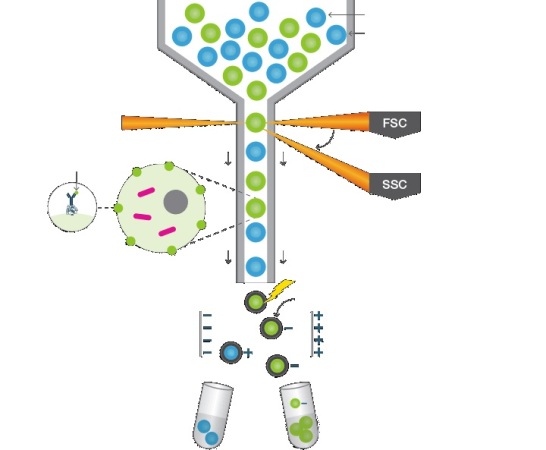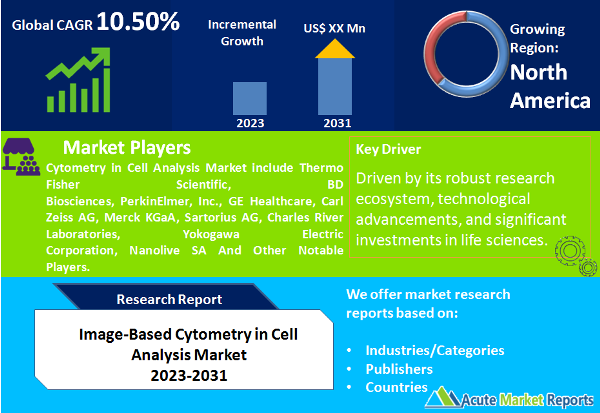
The image-based cytometry in cell analysis market is expected to grow at a CAGR of 10.50% during the forecast period of 2025 to 2033, image-based cytometry in cell analysis market is a dynamic sector that plays a pivotal role in advancing cell analysis and research through innovative imaging technologies. The Image-Based Cytometry in Cell Analysis Market is driven by technological advancements, personalized medicine trends, and the integration of AI and ML technologies. However, the complexity of data interpretation presents a challenge to harnessing the full potential of image-based cytometry. North America currently leads the market, while the Asia-Pacific region is projected to experience the highest growth. Industry leaders' strategies revolve around innovation, collaborations, and user-friendly solutions that empower researchers to unlock the complexities of cellular behavior through image-based cytometry.

Advancements in Imaging Technologies
The rapid evolution of imaging technologies has been a primary driver of Image Based Cytometry in the Cell Analysis Market. Innovations such as high-resolution microscopy, confocal microscopy, and super-resolution imaging have transformed cell analysis by enabling researchers to capture intricate cellular structures and dynamic processes at unprecedented levels of detail. These advancements have expanded the capabilities of image-based cytometry, making it an indispensable tool in various fields, including drug discovery, cancer research, and regenerative medicine.
Growing Demand for Personalized Medicine
The shift towards personalized medicine has fueled the demand for image-based cytometry in cell analysis. This approach requires a deep understanding of cellular behavior and heterogeneity, which image-based cytometry can provide through single-cell analysis. By examining individual cells within a heterogeneous population, researchers gain insights into cellular variations and responses, facilitating the development of targeted therapies and personalized treatment strategies.
Integration of Artificial Intelligence (AI) and Machine Learning (ML)
The integration of AI and ML technologies with image-based cytometry has revolutionized cell analysis. These technologies enable automated and high-throughput analysis of vast amounts of imaging data, allowing researchers to extract meaningful information efficiently. AI-driven image analysis enhances the speed and accuracy of cell analysis, aiding in the identification of subtle cellular changes, rare events, and complex patterns that might be missed using traditional manual approaches.
The Complexity of Data Interpretation
A significant restraint in the Image Based Cytometry in Cell Analysis Market is the complexity of data interpretation. The integration of advanced imaging technologies and AI-driven analysis generates vast amounts of data, which require expertise in both image analysis and biological interpretation. Researchers often face challenges in deciphering complex data sets, identifying relevant biological insights, and translating findings into actionable knowledge.
Biotechnology and Pharmaceutical Companies Dominate the End-User Segment
The market is segmented by end-user into Biotechnology and pharmaceutical Companies, Therapeutic Areas, Workplaces, Academia, Cosmetic Industry, Contract Research Organizations (CROs), and Contract Development and Manufacturing Organizations (CDMOs). Each segment encompasses distinct needs and applications for image-based cytometry. Biotechnology and pharmaceutical Companies are leveraging image-based cytometry for drug discovery and development, while academia utilizes it for fundamental research. CROs and CDMOs play a pivotal role in providing outsourced image-based cytometry services to support various industries. In 2024, biotechnology and pharmaceutical companies accounted for a significant portion of the market revenue. These industry players utilize image-based cytometry to enhance drug discovery, optimize treatment regimens, and monitor the effects of therapeutics at the cellular level. The adoption of image-based cytometry aids in identifying potential drug candidates, evaluating their mechanism of action, and assessing their impact on cellular pathways. As the demand for personalized medicine grows, biotechnology and pharmaceutical companies are projected to exhibit a robust Compound Annual Growth Rate (CAGR) from 2025 to 2033. This growth is attributed to the integration of high-content imaging technologies and advanced data analysis tools to accelerate drug development and improve treatment outcomes.
North America Remains as the Global Leader
North America dominated the Image Based Cytometry in Cell Analysis Market in 2024, driven by its robust research ecosystem, technological advancements, and significant investments in life sciences. Europe and the Asia-Pacific region also hold substantial market shares due to their growing research activities and expanding pharmaceutical and biotechnology sectors. The Asia-Pacific region is expected to exhibit the highest CAGR from 2025 to 2033. Rapidly growing economies, increasing research collaborations, and a rising focus on precision medicine contribute to the region's anticipated growth.
Market Competition to Intensify during the Forecast Period
Key players in the Image Based Cytometry in Cell Analysis Market include Thermo Fisher Scientific, BD Biosciences, PerkinElmer, Inc., GE Healthcare, Carl Zeiss AG, Merck KGaA, Sartorius AG, Charles River Laboratories, Yokogawa Electric Corporation, and Nanolive SA. These industry leaders focus on developing advanced imaging platforms, software solutions, and integrated systems that cater to diverse research needs. Strategic approaches involve partnerships with research institutions, technology collaborations, and the introduction of innovative imaging modalities. The market is characterized by a strong emphasis on user-friendly interfaces, automation, and software-driven analysis to enhance accessibility and ease of use.
Historical & Forecast Period
This study report represents analysis of each segment from 2023 to 2033 considering 2024 as the base year. Compounded Annual Growth Rate (CAGR) for each of the respective segments estimated for the forecast period of 2025 to 2033.
The current report comprises of quantitative market estimations for each micro market for every geographical region and qualitative market analysis such as micro and macro environment analysis, market trends, competitive intelligence, segment analysis, porters five force model, top winning strategies, top investment markets, emerging trends and technological analysis, case studies, strategic conclusions and recommendations and other key market insights.
Research Methodology
The complete research study was conducted in three phases, namely: secondary research, primary research, and expert panel review. key data point that enables the estimation of Image-Based Cytometry in Cell Analysis market are as follows:
Market forecast was performed through proprietary software that analyzes various qualitative and quantitative factors. Growth rate and CAGR were estimated through intensive secondary and primary research. Data triangulation across various data points provides accuracy across various analyzed market segments in the report. Application of both top down and bottom-up approach for validation of market estimation assures logical, methodical and mathematical consistency of the quantitative data.
| ATTRIBUTE | DETAILS |
|---|---|
| Research Period | 2023-2033 |
| Base Year | 2024 |
| Forecast Period | 2025-2033 |
| Historical Year | 2023 |
| Unit | USD Million |
| Segmentation | |
End-User
| |
|
Region Segment (2023-2033; US$ Million)
|
Key questions answered in this report